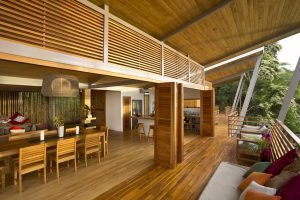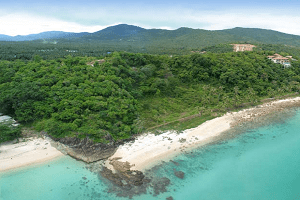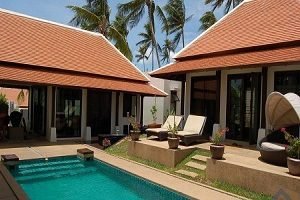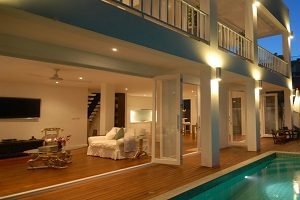Sunplay Bang Saray, a new luxury housing development in Chonburi province, aims to benefit from the Thai government’s much-hyped Eastern Economic Corridor (EEC) industrial, logistics and infrastructure development program, at least in terms of its sales pitch.
“We are fortunate to be where we are, when we are, having the EEC going ahead at the same time,” said Chris Delaney, managing director of Sunplay Asia Ltd, Sunplay Bang Saray’s developer.
But Delaney, a long-time veteran on Thailand’s property scene, claims interest has been high, with 50% of the potential buyers from Thailand and 50% expatriates, most of them based in Southeast Asia.

Although the Bang Saray project was initiated around two years ago, before the EEC program was announced in July 2016, it stands to benefit from the scheme by the time its first phase of houses are ready in December, especially with government plans to upgrade U-Tapao Airport, which should facilitate better regional access to the area.
Originally built by the US military in the 1960s to serve as a base for B-52 bombing raids on Indochina, U-Tapao is now being transformed into a commercial aviation hub for the EEC and potentially a maintenance, repair and overhaul (MRO) center for Airbus SE, if all goes according to plan.
“It’s only going to do positive things for land prices and property prices in the area,” Delaney said of U-Tapao, a 20-minute drive from Sunplay Bang Saray. “I think right now betting on direct flights from U-Tapao to Hong Kong and Singapore is safer than betting on Bitcoin. It will happen.”
Currently, U-Tapao Airport, with an annual capacity for 1 million passengers, chiefly serves low-cost carrier Air Asia in operating flights to China, the main source of Thailand’s tourists nowadays.
Some 9.8 million Chinese tourists visited Thailand in 2017 (out of 34 million international visitors), with more than 2 million traveling to Pattaya beach resort, another potential beneficiary of the EEC plan.
Sunplay Bang Suray, which is marketed to potential Chinese buyers, is situated about 25 kilometers south of Pattaya, Thailand’s jaded, somewhat sleazy, overbuilt city-cum-beach-resort in Chonburi province that is also hoping for a little property fillip from the EEC project.

The EEC, comprising the three eastern provinces of Chachoengsao, Chonburi and Rayong, has been slated for an estimated 500 billion baht (US$16 billion) in new public sector infrastructure expenditures over the next five years by the military-installed government of Prime Minister Prayuth Chan-ocha.
The EEC is basically a revised, updated version of the “Eastern Seaboard,” Thailand’s successful mega-project of the 1980s which transformed the same region into an industrial corridor for the kingdom’s petrochemical industry, automobile, electronics and electrical appliances industries that have fueled the nation’s export-led growth over the past three decades.
The EEC aims to attract foreign direct investment and expert labor into higher-tech, higher value-added sectors.
In that direction, the government plans to invest 215 billion baht (US$6.8 billion) to upgrade U-Tapao Airport, 45.5 billion baht (US$1.4 billion) upgrades of Map Ta Phut and Laem Chabang deep sea ports – essential components of the original Eastern Seaboard – 64 billion baht (US$2 billion) on a double-track railway to Laem Chabang and 158 billion (US$5 billion) on a high-speed train linking U-Tapao to Suvarnabhumi Airport and Don Mueang Airport – Bangkok’s two international airports.
“The Eastern Seaboard has been the economic driver for Thailand but over the last ten years the region has been somewhat ignored in terms of infrastructure improvements so it is welcome news that the government is refocusing on a location,” said James Pitchon, executive director of CBRE, an international property consultant.
How many of the EEC infrastructure mega-projects materialize remains to be seen, especially with a general election looming in late 2018 or early 2019. New administrations in Thailand tend to scuttle the outgoing government’s plans.

“The jury is still out on what will stick, but obviously they are throwing a lot of stuff at it,” Pitchon said.
Foreign direct investment (FDI) in the EEC has adopted a similar wait-and-see stance on the program, although interest appears to be on the uptick, judging by new applications for new projects via the government’s Board of Investment (BOI) last year.
There were 1,456 new project applications in 2017, worth 641.9 billion baht (US$20.2 billion), of which 46%, or 296.9 billion (US$9.3 billion), was for projects in the EEC, up 49% year-on-year, according to BOI figures.
Even if FDI actually starts to flow into the EEC, some question whether it will spark huge the demand for new housing in the area, as eventually happened with the Eastern Seaboard when migrant factory workers became home owners in the provinces.
“If the industrial projects start there will be more demand in the near future, but the demand will be different than 30 years ago,” said Vichai Viratkapan, acting director general of the government’s Real Estate Information Center (REIC).

“The EEC industries require skilled labor and technicians, which might be a market for medium level housing estates in the future,” he said.
Newcomers will find that there are already plenty of housing projects and condominiums available in the area, especially in Chonburi province, site of major residential clusters at Sri Racha, Pattaya and Jomtien beach resorts – and now a newcomer, Sunplay Bang Saray.
After three years of slow property sales, a mirror of Thailand’s flaccid economic growth between 2014 to 2016, things can only get better, regional realtors hope.
“Previously you could guarantee a launch party of some new development every week, but in the past two-three years I’ve only been to one such party,” Bowling said. “Everything just dried up about the time the military came along,” he said, referring to the May 2014 coup that brought Prayuth to power.










